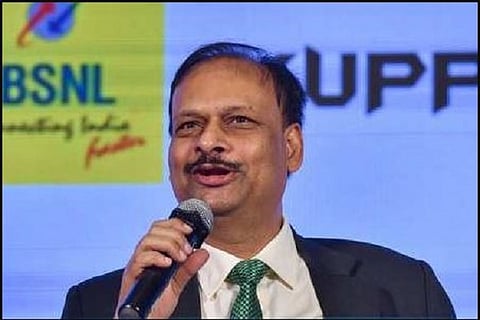
- News Updates
- PSU Watch
- Defence News
- Policy Watch
- हिन्दी न्यूज़
- Jobs Watch
- States News
- Event News

New Delhi: Telecom towers, which transmit signals that help make voice calls and help access the internet on mobile phones, require an estimated Rs 2-3 lakh crore per annum to maintain, the head of state-owned BSNL said on Tuesday as he called for technological solutions for bringing down cost.
Speaking at 'Driving India's Techade: D2M for Bharat - 5G Broadcast Summit', BSNL chairman and managing director Pravin Kumar Purvar said even direct-to-mobile (D2M) broadcasting, which transmits multimedia content to consumers' smartphones without requiring an active internet connection using a technology that is employed for issuing emergency alerts and assisting in disaster management - too would require towers.
"Can we create 7 lakh towers across the country? I think it is practically not feasible," he said.
Setting up a tower is "not a big thing" as it requires about Rs 30 lakh, he said.
"But, fuelling it every day requires a cost, which is almost, in my opinion, Rs 2-3 lakhs per annum."
The price of running a telecom tower includes costs for electricity, diesel or other fuel for generators, security, maintenance, and lease or rent payments for the land, where the tower is located.
"So, what is required is that both the D2M technology and telecom operator have to work in tandem to bring down the cost. Unless and until you bring down the cost, the arbitrary capacity is only one," he said. For running the towners, revenue streams equivalent to running costs need to be created.
"So, I think the most important part is how we can create a cost-effective method... I think that's the big challenge as on date for any technology, including telecom operators and D2M."
Purvar said the telecom and the D2M business are dependent on the pricing of the spectrum - whether signal-carrying airwaves should be charged or should be priced at a non-price cost.
"Otherwise everything is almost similar so far as the visual is concerned. So, from where the revenue stream will come and where the costs are going. So, unless D2M technology is price sensitive or low price or least priced with a low cost, only then it will make a business sense," he said.
Calling the rural-urban divide an artificial one, the BSNL head said the fibre to the home (FTTH) consumption per customer in urban areas is 230 per GB per month, while in the 7 lakh FTTH, the state-owned firm running on BharatNet infrastructure in rural areas sees 187 GB per month.
"That means, there is absolutely no demand shortage so far as the rural landscape is concerned," he said.
BSNL on behalf of the government is connecting 26,000 villages with the 4G technology.
"In the next 9 months, there will be no village in the country which doesn't have 4G connectivity," he said. "So, accessibility issues are addressed. But affordability issues still remain, both in terms of the device as well as the recurring costs."
Similarly, the government is very clear about bridging the digital divide between rural and urban India.
"So, we are implementing a very large, difficult and ambitious programme, in which, every single village of the country, 6 lakh villages have to be brought on optical fibre connectivity in the next 3 years. It is a USD 20 billion project, almost Rs 1.5 lakh crore project. It requires nearly 13 lakh kilometres of optical fibre to be laid to reach the over 6 lakh gram panchayat," he said.
(PSU Watch– India's Business News centre that places the spotlight on PSUs, Bureaucracy, Defence and Public Policy is now on Google News. Click here to follow. Also, join PSU Watch Channel in your Telegram. You may also follow us on Twitter here and stay updated.)
